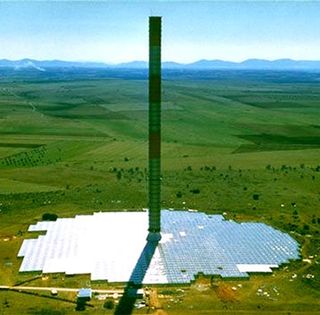How a Giant Solar Tower Could Power the Future

Editor's Note: Each Wednesday LiveScience examines the viability of emerging energy technologies — the power of the future.
A new energy concept called a solar tower could generate enough electricity for 200,000 homes. Looking like a giant smokestack, it would release no noxious fumes — just sun-heated air.
Demonstrated more than 20 years ago, the basic design calls for solar collectors to warm the air near Earth's surface and then channel it up the tall central tower. Turbines placed at the bottom make electricity from the updraft.
"It's a combination chimney, windmill, greenhouse," said Kim Forté of EnviroMission Limited in South Melbourne, Australia.
EnviroMission has designed a kilometer-high solar tower (0.62 miles) and is now looking at possible sites in the southwestern United States.
Solar-stack
The solar tower is an updated version of a solar chimney — a centuries-old technique for providing ventilation to a home by creating a natural updraft from sun-heated air.
Sign up for the Live Science daily newsletter now
Get the world’s most fascinating discoveries delivered straight to your inbox.
The physics is also similar to the atmospheric vortex engine, where a man-made tornado funnels warm air up into the sky. Even though this vortex could extend higher than a solid structure, only the solar tower has been demonstrated to work, Forté said.
In 1982, a small prototype was installed in Manzanares, Spain. Its tower was 195-meters-tall and was surrounded by a transparent canopy that covered an area of about 244 meters in diameter.
As it was primarily a test facility, the maximum power output was only 50 kilowatts. Inexpensive materials were purposefully used to minimize costs, but eventually a storm blew the tower over in 1989.
In comparison, EnviroMission’s design calls for a concrete tower that should last 50 years, Forté told LiveScience.
Up, up in the sky
The company's plan is not only to build stronger, but also taller. This allows for a greater temperature difference between the ground and the top of the tower, and this difference makes for more powerful suction up the chimney structure.
The optimum configuration is an 800- to 1,000-meter tower (twice the height of the Empire State Building) surrounded by a greenhouse canopy 1.5 miles (2.5 kilometers) in radius on the ground.
"It is a sizeable footprint [on the land], but with the rising cost of carbon fuels, it's becoming more commercial," Forté said.
On a sunny day, the air at the top of the tower would be 70 degrees Fahrenheit (20 degrees Celsius), whereas the air in the greenhouse could reach 160 degrees Fahrenheit (70 degrees Celsius). As this hot air escapes up the tower at 34 mph (15 meters per second), it spins 32 turbines that generate up to 200 megawatts of electricity.
Even with all this power, the solar tower is less than one tenth as efficient as solar cells in converting the sun's energy into electricity.
The advantage for a solar tower is that its materials are much less expensive.
A 200-megawatt solar tower would cost upwards of a billion dollars to build. According to a 2005 industry report, this would imply about 10 cents per kilowatt-hour, which is roughly a third of the cost of electricity from current solar cells.
However, a solar tower must be fairly big to be effective. EnviroMission has recently developed a slightly smaller design that has a maximum output of 50 megawatts that may be appropriate in some markets.
Lacking sufficient financial support in Australia, the company is now in negotiations with SolarMission Technology Inc., which owns the license to the technology in the United States. Waiting on a deal, EnviroMission is evaluating the weather patterns at four U.S. sites.
Although the solar tower has less output at night, Forté said that it does supply a more constant supply of power during the day than simple wind turbines. And compared to traditional technologies — such as coal, natural gas and nuclear — the solar tower is certain to have "fuel" in the future.
"We do know the sun will rise and set every day," Forté said.
- Innovation: Ideas and Technologies of the Future
- How a Man-Made Tornado Could Power the Future
- Archive of 'Power the Future' Articles
Most Popular


